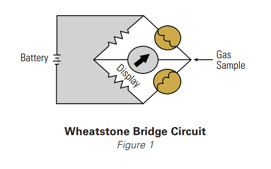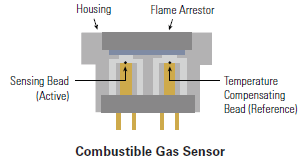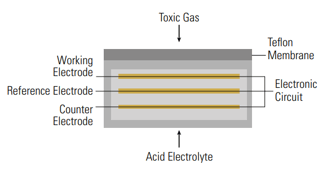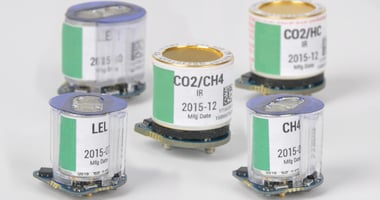There are two very common sensor types used in gas detectors today: catalytic diffusion sensors, and electrochemical sensors. Keep reading to learn more about how they work.
Catalytic Diffusion Sensor

Catalytic diffusion sensors are the most widely used devices for the detection of combustible gases and vapors. These sensors start with wire being wound into coils. These coils are then doped with two types of catalysts: one to make the element active and one to make it blind. These different coils are then matched into pairs of reference and sensing elements. This forms a combustible gas sensor.
This sensor is then placed into a circuit, where a fixed voltage is applied across both elements, causing them to heat up to very high temperatures. The sensor is also connected to a balanced resistance, a Wheatstone bridge, which detects changes in the resistance of the sensor's elements. When a combustible gas comes in contact with the sensor, the active element begins to burn the gas causing it to increase the temperature. The temperature of the reference element remains unchanged because it is incapable of burning gas. The increased heating of the active element causes an unbalance in the circuit and this is interpreted as a positive combustible signal.

Because combustion is taking place within the sensor chamber the sensor must be designed and built in such a way that it is intrinsically safe and will not act as an ignition source in the event it is exposed to a combustible atmosphere. This is accomplished through the use of a flame arrestor. This device, usually made of a sintered material, acts as a cooling path for gases escaping the sensor. Only units that have been tested and approved by third party approval agencies, (UL, CSA, MSHA, FM or CENELEC) can be trusted to be intrinsically safe.
Electrochemical Sensor

The basic components of an electrochemical sensor are a working (or sensing) electrode, a counter electrode, and usually a reference electrode. These electrodes are enclosed in the sensor housing in contact with a liquid electrolyte. The working electrode is on the inner face of a Teflon membrane that is porous to gas, but impermeable to the electrolyte.
The gas diffuses into the sensor and through the membrane to the working electrode. When the gas reaches the working electrode, an electrochemical reaction occurs; either an oxidation or reduction depending on the type of gas. For example, carbon monoxide may be oxidized to carbon dioxide, or oxygen may be reduced to water. An oxidation reaction results in the flow of electrons from the working electrode to the counter electrode through the external circuit; and conversely a reduction reaction results in flow of electrons from the counter electrode to the working electrode. This flow of electrons constitutes an electric current, which is proportional to the gas concentration. The electronics in the instrument detects and amplifies the current and scales the output according to the calibration. The instrument then displays the gas concentration in, for example, parts per million (PPM) for toxic gas sensors and percent volume for oxygen sensors.
For more information about gas detector fundamentals, check out our blog post on the key features to look for in a personal monitor: How to Choose a Personal Gas Detector: 8 Features You Need.



